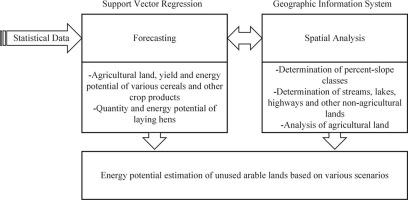Engineering Science and Technology, an International Journal ( IF 5.1 ) Pub Date : 2021-05-08 , DOI: 10.1016/j.jestch.2021.04.011 Ahmet Alp Senocak , Hacer Guner Goren

|
To meet the energy demand in a sustainable way, fossil fuels must be substituted with alternative resources and technologies. This transformation is encouraged to reduce greenhouse gases using environmental-friendly practices. Although our country is rich in biomass resources due to climate, land conditions, agriculture and animal husbandry activities, the installed power is quite below its potential. Focusing on this point, the aim of this study is to propose a forecasting method that determines the quantities, distributions, production amounts, waste amounts and energy potential of various biomass resources consistently. The integrated method used in the solution utilizes statistical data and consists of artificial intelligence and geographic information systems. First of all, various bioenergy sources that can be used as energy resources have been determined, and the amount, yield, and energy potential of animal and agricultural wastes expected to occur in the following years have been estimated using an artificial intelligence-based method, support vector regression. Then, spatial analysis has been carried out using geographic information systems, and the distribution of existing and possible agricultural lands has been determined. Finally, the amount of energy that can be obtained using wastes from different biomass sources under various scenarios has been calculated and solutions have been compared. To the best of our knowledge, this study is the first proposing an integrated method consisting of support vector regression and geographic information systems to forecast the biomass-based energy potential in Turkey. The integrated method was applied to Acıpayam district in Denizli. Among the various scenario approaches, the cultivation of rapeseed (canola) plants on non-utilized arable land and the use of its wastes in bioenergy production have been found to yield the highest energy potential. The results showed that approximately 29,2%, 27,8%, and 27,6% energy increase could be obtained from agricultural residues of rapeseed in the next three years if it was planted on the quarter of the idle land. Besides, under this scenario, the total annual electricity demand of 6972, 6663 and 6545 houses could be met from agricultural residues in a sustainable and clean manner. The proposed method can be applied to different regions, various biomass resources and used to make strategic decisions in this field.
中文翻译:

使用人工智能和地理信息系统预测基于生物质的能源潜力:一个案例研究
为了以可持续的方式满足能源需求,必须用替代性资源和技术替代化石燃料。鼓励进行这种转换以使用环保做法减少温室气体。尽管由于气候,土地条件,农业和畜牧业活动,我国生物质资源丰富,但装机功率却远远低于其潜力。着眼于这一点,本研究的目的是提出一种预测方法,该方法可以一致地确定各种生物质资源的数量,分布,生产量,废物量和能源潜力。该解决方案中使用的集成方法利用统计数据,并由人工智能和地理信息系统组成。首先,确定了可用作能源的各种生物能源,并使用基于人工智能的方法(支持向量回归)估算了预计在未来几年发生的动物和农业废物的数量,产量和能源潜力。然后,已使用地理信息系统进行了空间分析,并确定了现有和可能的农业用地的分布。最后,计算了在各种情况下使用来自不同生物质资源的废物可获得的能量,并对解决方案进行了比较。据我们所知,这项研究是第一个提出了一种综合方法,该方法包括支持向量回归和地理信息系统,以预测土耳其基于生物质的能源潜力。集成方法已应用于代尼兹利的Acıpayam地区。在各种方案方法中,已发现在未利用的耕地上种植油菜籽(菜籽油)植物并将其废物用于生物能源生产可产生最高的能源潜力。结果表明,如果将其种植在闲置土地的四分之一处,则在未来三年中,可从油菜籽的农业残留物中获得大约29,2%,27.8%和27.6%的能量增加。此外,在这种情况下,可以通过可持续,清洁的方式利用农业残留物满足每年6972、6663和6545座房屋的总电力需求。所提出的方法可以应用于不同地区,各种生物质资源,并可以在该领域做出战略决策。











































 京公网安备 11010802027423号
京公网安备 11010802027423号